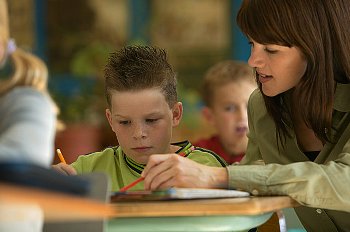Home » Mathematics
Category Archives: Mathematics
News Update: Sexism in the Classroom
This past February, Danielle Kurtzleben’s article, “Grade-school teachers can push girls away from math, with huge consequences,” appeared in Vox, speaking to some very important and, tragically, very widespread misconceptions regarding the gender “math gap” in education. According to Kurtzleben:
“A new working paper from the National Bureau of Economic Research suggests that something else might be at work here shaping the supposed ‘choices’ girls and women make. It shows that young girls’ teachers have biases that push girls away from math and science early on, which could be influencing where they go later in life.
Economists Victor Lavy from the University of Warwick in the United Kingdom and Edith Sand from Israel’s Tel Aviv University looked at Tel Aviv sixth graders’ test scores both on standardized tests and internal tests in Hebrew, English, and math.”
In this research, Lavy and Sand tested to see if there was any difference in test scores if the ones responsible for grading the tests knew or did not know the test-takers’ gender. Their results clearly suggest the existence of a “systematic bias against girls in the marking of math exams.” And as Lavy and Sand followed their sixth-graders through the eighth grade and high school, they found that “those early teacher biases led to significant improvements on the later math exams for boys and negative and significant effects in math for girls.”
Of course, as Kurtzleben also points out, “this is a working paper, meaning its results are preliminary, and it studied students in a different culture and school system, so we can’t assume US students would see the exact same magnitudes of effects” (emphasis added). However, what’s most important about this research now, as Kurtzleben explains, is that it shows how powerfully “socialization takes hold early on” as well as showcases
“the power of biases — discourage a child from pursuing a subject, and she will, years later, later perform worse on that subject (encourage her, meanwhile, and she’ll do better). So when you discourage a whole swath of the population from pursuing high-paying fields, all those people will be much more likely to have lower-paying jobs.”
What does this mean for us in the here and now? What does it mean for us as parents, teachers, and/or fellow students? It means constantly interrogating ourselves and our assumptions. It means asking ourselves hard questions before we hand back that test or agree with our daughters that Yeah, math really is boring or Yeah, math is super hard, when we might be telling our sons, Yeah, but you can do it or Yeah, but you want to be a marine biologist one day, don’t you? The insidious evil of sexism is that you can sometimes be adding to the problem and perpetuating old sins without ever realizing it or meaning to.
This is a trend and social failing that should both greatly concern and anger you, for your sake as well as for the rest of the world’s. After all, as Kurtzleben so well explains:
“This isn’t just a problem for women; it’s a problem for society. This study suggests that girls were just as capable as boys at math at the start of the observation period, but they were slowly pushed away from math. To diminish an entire demographic’s talent at once is to squander their potential productivity, and economic growth.”
If we want to one day live in a better, more just, more equitable, and more peaceful world, then there’s really no better or easier place to start than right at home with the editing, improving, and monitoring of our own attitudes, perspectives, and actions. The hard truth is, we will only have justice and equality for all when we begin treating others justly and equitably.
All quotes and facts here were drawn from Danielle Kurtzleben’s Vox article, “Grade-school teachers can push girls away from math, with huge consequences.”
Maker Movement in Classrooms?
First, I’d like to thank My School of Thought for posting such an excellent article on The Maker Movement. As a tutor and “maker” myself, I couldn’t be more thrilled by the take-off of this movement and am very hopeful for the future of our classrooms knowing that more and more teachers are beginning to incorporate more opportunities for students to build, explore, and engage with the materials they’re learning in new ways.
Just take Allen High School’s Blu Bistro, for example. When I was a student of AHS (I can’t believe how many years ago now that was!), cooking classes were basically nonexistent, but were in the works as a possible future extracurricular option for students. And now? Now AHS’ student chefs are not only serving restaurant-quality food of their own making to Allen community residents, but they’re also competing in kitchens across the state of Texas (in both cooking and restaurant management) including in the 2013 Texas Pro-Start Invitational state finals wherein dishes were judged by “members of the Texas Restaurant Association and chefs from culinary schools such as Le Cordon Bleu and The Culinary Institute of America” (Wendy Gragg, Waco Trib). These students are learning to be Makers of a different kind than the Engineering students we’ve started hearing so much about, but they’re Makers just the same. It’s in the art of being a producer that students can often start finding new interests and motivations for themselves to learn and become more active consumers.
As Dale Dougherty, editor of Make Magazine, explains in My School of Thought’s post, “…I want people to see themselves as producers, not just consumers. I’d like to see it become a capability that we use in home life and at work and that we’re proud of it, where we see ourselves as having these powers to do stuff.” I couldn’t agree more. Being a consumer, while fun, challenging, and interesting in its own right, is often today conflated with being more passive whereas being a producer seems to naturally mean being more active and invested in the product itself. But this does not always have to be the case. Rather, by encouraging children and friends to be more active producers, we can help them and ourselves become more active consumers as well.
We often see this in English courses where some students can have trouble getting interested in assigned readings yet leap at the opportunity presented by a creative writing project. Why is this? It isn’t because students are inherently lazy or come out of the womb not enjoying to read or don’t understand the connection between writing and reading — loving reading, loving science, loving learning (loving being a consumer of knowledge) are all things that must be taught and demonstrated for children from an early age. How can you be a creative writer without also learning to love and actively engage in the process of reading — in the process of consuming written materials? How can you be a builder without also learning to love and actively consume the necessary mathematics and scientific principles?
The answer is simply that you cannot — but you can sometimes begin as a producer and so work your way into becoming a more active consumer.
These two identities, these two ways of learning — producing and consuming — feed into each other in a natural cycle. So who’s to say that you need to have one first before the other can follow? Why not let kids try their hand at building or writing or cooking something before they’ve learned all the elemental pieces? — It might just be the kick-in-the-pants they need to start asking questions, to realize what might be out there for them to learn from the cookbooks, mathematicians, and libraries. And the best part is, if the students are the ones asking and seeking answers to their own questions, then they’re also learning to consume knowledge within a useful context and in a more active manner; they’re learning to consume and apply knowledge for a purpose, rather than simply memorizing facts because a school or standardized test demanded it (which can often lead to those facts seeming disjointed and useless). Learning information for a purpose or as part of a larger narrative of questions and exploration can often be key to that information being retained and applied in new ways. Our children learn from us — their mentors, parents, and teachers — what it means to have fun in one’s leisure time. If we spend all of our leisure time watching TV, then that’s what they, our children, will associate with down-time rather than more active and mind-engaging activities like reading, building, writing, or exploring.
And this is why we can’t leave the Maker Movement up solely to our schools and teachers. If we want our children to be more enthusiastic creators and more active consumers, then we must model this behavior for them and become more active and interested ourselves. This can be as simple as swapping out a night of television for a night of reading or puzzle-piecing or fort-building or creative writing or cooking or gardening or scavenger-hunting.
It can be as easy as learning to have fun with each other again.



